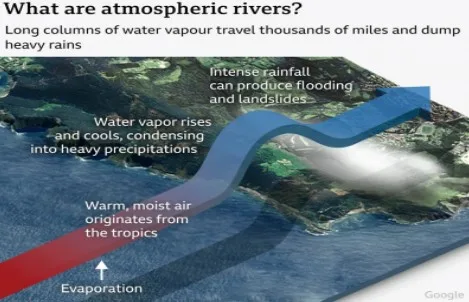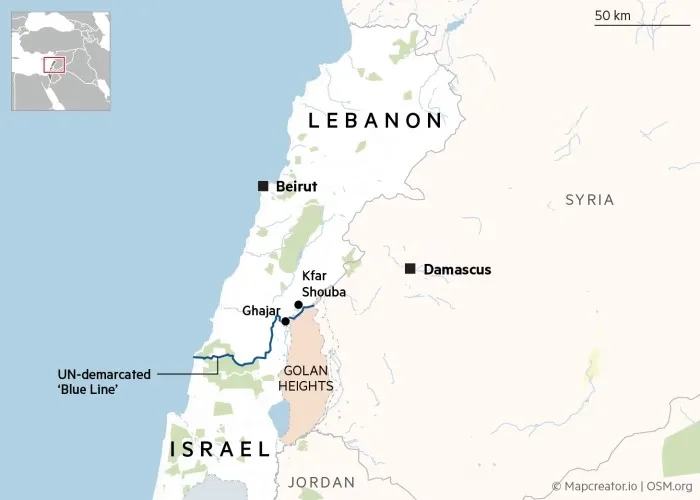Northeast Monsoon (Retreating Monsoon)
Syllabus: GS1/Climate
Context
- The northeast monsoon set in over Tamil Nadu and Puducherry, bringing heavy rain to the northern parts of the State.
About
- The Northeast Monsoon, also known as the Retreating Monsoon, occurs from October to December and is characterized by winds blowing from the northeast.
- This monsoon primarily affects southeastern India, including Tamil Nadu, and parts of the eastern coast.
- During this period, the northeast trade winds bring moisture from the Bay of Bengal, resulting in rainfall.
- The Northeast Monsoon is crucial for replenishing water supplies in regions with less rain during the Southwest Monsoon.
Source: DTE
Atmospheric Rivers
Syllabus: GS1/Geography
Context
- According to a new study atmospheric rivers have shifted about 6 to 10 degrees toward the two poles over the past four decades, changing weather patterns around the world.
About
- Atmospheric Rivers are the storms that travel as huge, invisible ribbons of water vapor and dump heavy rains.
- An average atmospheric river is about 2,000 km long, 500 km wide and nearly 3 km deep.
- These “rivers in the sky” carry some 90% of the total water vapor that moves across the Earth’s mid-latitudes.
Impact of Atmospheric Rivers
- The water vapor forms a band or a column in the lower part of the atmosphere which moves from the tropics to the cooler latitudes and comes down as rain or snow, devastating enough to cause floods or deadly avalanches.
- As the earth warms up faster, scientists say these atmospheric rivers have become longer, wider and more intense, putting hundreds of millions of people worldwide at risk from flooding.

Source: DTE
Blue Line
Syllabus: GS1/ World Geography
In News
- The United Nations reported that Israeli forces have fired upon its peacekeepers stationed near the Blue Line.

About Blue Line
- It is a 120-km United Nations-recognized demarcation, established in 2000 to mark the withdrawal of Israeli military forces from southern Lebanon.
- It separates Lebanon from Israel and the Golan Heights, though it is not recognized as an official international border.
- The line is made of blue barrels and runs from the Mediterranean to the Golan Heights.
Source: TH
eMigrate V2.0 Web Portal
Syllabus: GS2/ Governance; Government Initiatives
Context
- External Affairs Minister Dr S Jaishankar has inaugurated the eMigrate V2.0 web portal and Mobile App.
About
- The eMigrate portal promotes safe and legal mobility channels for Indian workers going abroad.
- The upgraded platform offers 24/7 multilingual helpline support and a feature for feedback, ensuring timely redressal of issues faced by workers abroad, especially in the Gulf region.
- The platform also supports job-seekers by offering a one-stop marketplace for overseas employment opportunities.
- The portal aligns with Goal 10 of the 2030 Agenda for Sustainable Development Goals which promotes the facilitation of orderly, safe, regular, and responsible migration and mobility of people.
Source: AIR
Diphtheria
Syllabus: GS2/Health
Context
- Recently, Children in the Deeg district of Rajasthan died due to diphtheria.
About
- It is a highly contagious, infectious disease caused by a bacterium called Corynebacterium diphtheriae.
- It affects children from newborns to 16 years of age.
- The bacteria most commonly infects the respiratory system.
- It makes a toxin that kills healthy tissues in the respiratory system.
- Symptoms: Sore throat, fever, chills, swollen lymph nodes, skin sores, and weakness.
- Treatments: Antibiotics and an antitoxin that neutralizes the diphtheria toxin. A vaccine is available.
- It is covered under the Universal Immunization Program in India.
Source: IE
Sharp Rise in Cancer Cases
Syllabus :GS 2/Health
In News
According to a study by the Indian Council of Medical Research-National Centre for Disease Informatics and Research, Cancer cases and deaths in India are expected to sharply increase between 2022 and 2045.
About the study
- The study assessed cancer trends in BRICS countries (Brazil, Russia, India, China, and South Africa), finding similar trends in South Africa.
- Incidence Increase: A projected 12.8% increase in cancer incidence in India is expected by 2025 compared to 2020, linked to rising life expectancy.
- Leading Cancer Types:
- Among men, the most common cancers are prostate, lung, and colorectal.
- India has a notably high incidence of lip and oral cavity cancers due to high tobacco consumption.
- For women, breast cancer is the leading cancer type across BRICS, except in China, where lung cancer is more prevalent.
- Cervical cancer is the second leading cancer in India and South Africa.
- Among men, the most common cancers are prostate, lung, and colorectal.
- Factors: Low socioeconomic status and lifestyle risk factors contribute significantly to the high rates of oral cancer.
- Global Impact: BRICS countries account for over a third of new breast cancer cases and deaths worldwide, showing an upward trend in incidence.
- Lung cancer is the leading cause of death in all BRICS countries except India, where breast cancer leads.
- Trachea, bronchus, and lung cancers contribute significantly to Disability Adjusted Life Years (DALYs), but breast cancer is the most significant in India.
Suggestions
- The researchers emphasize the importance of investigating cancer risk factors and health systems to improve cancer outcomes in the context of sustained economic growth and existing cancer control plans in BRICS countries.
Source :DTE
World Telecommunication Standardization Assembly (WTSA)
Syllabus :GS 3/Economy
In News
The Prime Minister inaugurated the World Telecommunication Standardization Assembly (WTSA) 2024 at Bharat Mandapam in New Delhi
- He also inaugurated the 8th edition of India Mobile Congress 2024 during the programme.
About WTSA
- It is the governing conference for the International Telecommunication Union (ITU), held every four years.
- This is the first time the assembly will be hosted in India and the Asia-Pacific region.
- The event attracted over 3,000 leaders, policymakers, and tech experts from more than 190 countries, focusing on telecom, digital, and ICT sectors.
- Focus Areas: Discussions covered the future of standards for critical technologies such as 6G, AI, IoT, Big Data, and cybersecurity.
- Importance for India : Hosting WTSA 2024 positions India to influence the global telecom agenda and future technology standards.
- Indian startups and research institutions are expected to gain valuable insights into Intellectual Property Rights and Standard Essential Patents.
| Do you know ? – India Mobile Congress, Asia’s largest digital technology forum, has become a well-known platform across the globe for showcasing innovative solutions, services and state-of-the-art use cases for industry, government, academics, startups and other key stakeholders in the technology and telecom ecosystem. – The India Mobile Congress 2024 will showcase over 400 exhibitors, about 900 startups, and participation from over 120 countries. – The event also aims to showcase more than 900 technology use case scenarios, host more than 100 sessions and discussion with over 600 global and Indian speakers. |
Source:PIB
Dr. A P J Abdul Kalam
Syllabus :GS 3/Science and Tech; Achievements of Indians in S&T
In News
- Prime Minister pays tribute to Former President of India (11th), Dr A P J Abdul Kalam on his birth anniversary.
About Dr. A P J Abdul Kalam
- Dr. Avul Pakir Jainulabdeen Abdul Kalam was born on October 15, 1931, in Rameswaram, Tamil Nadu.
- He is known as the “Missile Man of India.”
- He specialized in Aeronautical Engineering from the Madras Institute of Technology.
- Major Contributions: As Project Director, he developed India’s first indigenous Satellite Launch Vehicle (SLV-III), successfully launching the Rohini satellite in 1980. Contributed to the PSLV configuration.
- He worked at DRDO, leading the Integrated Guided Missile Development Programme (IGMDP).
- Developed AGNI and PRITHVI missiles and focused on self-reliance in defense systems.
- He served as Scientific Adviser to the Defence Minister, overseeing the Pokhran-II nuclear tests that established India as a nuclear weapons state.
- He chaired the Technology Information, Forecasting and Assessment Council (TIFAC), guiding experts to create a roadmap for India’s development into a developed nation.
- He served as Principal Scientific Advisor to the Government from 1999 to 2001, influencing policies and strategies for national development.
- He worked at DRDO, leading the Integrated Guided Missile Development Programme (IGMDP).
- Literary Contributions: Authored notable books, including “Wings of Fire,” “India 2020,” “My Journey,” and “Ignited Minds,” widely read and translated into many languages.
- Awards and Honors: He was awarded the Padma Bhushan, Padma Vibhushan, and the highest civilian award, Bharat Ratna.
Source: PIB
Europa Clipper
Syllabus: GS3/Science and Technology
Context
- NASA has launched the Europa Clipper, to investigate Jupiter and its moon, Europa.
Europa Clipper
- The Europa Clipper is the largest spacecraft Nasa has built for planetary exploration.
- It will take five- and-a-half years to reach its destination, and Clipper will approach Europa at a distance of just 25 km from its surface.
Structure
- The spacecraft has massive solar panels to generate sufficient power required for the long distance between Jupiter and the Sun.
- The main body of the spacecraft has nine scientific instruments including radar to penetrate Europa’s icy shell, cameras to map its surface, and devices to analyze its atmosphere and composition.
About Europa
- Europa was discovered by Galileo Galilei in 1610, alongside three other moons (Io, Ganymede, and Callisto), collectively known as the Galilean moons.
- Europa is covered by an ice sheet estimated to be 15 to 24 km thick.
- Beneath this ice sheet, scientists believe there could be a subsurface ocean, possibly up to 120 km deep. It is making Europa a prime candidate for the search for extraterrestrial life within our solar system.
Source: BS
Ganges and Indus River Dolphins
Syllabus: GS3/ Environment
Context
- Recently a 8,000-kilometer aquatic survey was carried out by the Wildlife Institute of India (WII) for the assessment of dolphin populations.
Ganges River Dolphin (Platanista Gangetica)
- Characteristics: Ganges River Dolphin is essentially blind and hunts by emitting ultrasonic sounds (echolocation) waves that bounce off of fish and other prey.
- Because of the sound it produces when breathing, the animal is popularly referred to as Susu.
- Distribution: It is distributed in Ganges and Brahmaputra river basins of India, Nepal and Bangladesh. It can only live in freshwater.
- Threat: Ganges river dolphin is facing severe threats from water development projects, Pollution, hunting and death due to accidental catches in fishing gear.
- Conservation status: The Ganges river dolphin is protected under
- Schedule 1 of the Indian Wildlife (Protection) Act 1972,
- Appendix 1 of the Convention on International Trade in Endangered Species (CITES) and
- Appendix 1 of the Convention on Migratory Species (CMS).
- IUCN status: Endangered
- National and State Symbol: The Ganges river dolphin was designated as a national aquatic species in 2009 and as the state aquatic animal of Assam.
Indus River Dolphin (Platanista minor)
- Characteristics: The Indus River Dolphin is also functionally blind and relies on echolocation to navigate and find prey.
- It is commonly referred to as Bhulan in local languages.
- Distribution: The Indus River Dolphin is found in the Indus River system in Pakistan and a small population is present in the Beas River in India.
- Threat: Water diversion projects have significantly reduced its habitat range, confining populations to isolated sections of the river.
- Conservation Status: Protected under Schedule I of the Indian Wildlife (Protection) Act 1972 in India.
- Appendix I of the Convention on International Trade in Endangered Species (CITES).
- Appendix I of the Convention on Migratory Species (CMS).
- IUCN status: Endangered
- State Symbol: The Indus river dolphin is the state aquatic animal of Punjab.
Source: DTE